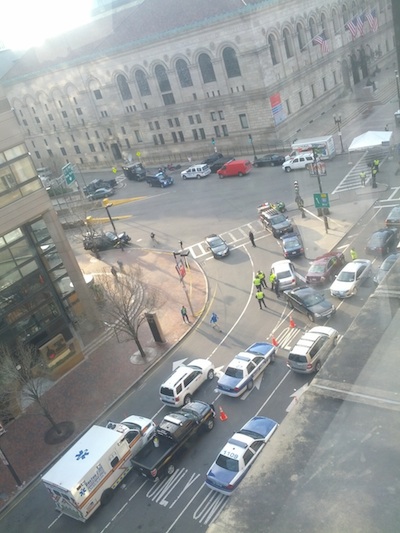By Janis Siegel ,
JTNews Columnist
In Boston on April 15, as in Israel, when an improvised explosive device detonated onto a crowd of innocent civilians at the finish line of the city’s signature marathon, bystanders instinctively and immediately rushed in to help the injured, tying improvised tourniquets on those with severed limbs, transporting them to waiting ambulances, and comforting others who were in utter shock.
But within minutes, when emergency first-responders arrived on the scene that afternoon on Boylston St., medics implemented a rescue operation with the precision and all of the skills they learned from their Israeli counterparts who helped train them, the Magen David Adom, Israel’s national emergency response organization.
Tasked with administering CPR, attending to traumatic injuries, mitigating severe blood loss, retrieving and covering severed body parts with sterile fabrics, readying patients for surgery, and transporting them safely to hospitals, Israel’s MDA had proactively instructed Boston disaster teams on what to do in those crucial first 10 minutes of a disaster.
“Those first magic 10 minutes, when the patient is really at the verge of life or death, is really where we come in,” said Erik Levis, assistant director for press relations and editorial content for the American Friends of Magen David Adom, speaking with JTNews from his New York office. “We get victims in a position to be helped once they get to the hospital.”
Recently, he said, several of their staff travelled to Boston and all over the U.S.to speak about best practices in these types of emergencies and he said, medical staff from Boston have travelled to MDA offices in Israel to see, firsthand, how they operate.
In December 2011, Kurt Schwartz, the undersecretary of homeland security for Massachusetts, went to Israel with homeland security and emergency medical services personnel from his state. He told JTNews they were focused on learning how to deal with a terror attack in the event that a device, much like the one that surfaced in Boston last month, was detonated.
“We made visits to several hospitals and to Magen David Adom’s headquarters,” said Schwartz. “What I learned and saw in Israel helped me in my response to the IED attacks in Boston.”
Also in 2011, Ori Shacham, a high-ranking official in the MDA, visited the Boston University Medical School to coach students and paramedics in their emergency management program. Shacham described how Israel integrates and coordinates the police, security, ambulances, and the fire department into an unfolding catastrophe.
“The level and quality of the people at Boston University were comparable to everything we see in Israel,” said Shacham. “The only thing they were lacking was experience, which unfortunately, we could provide to them.”
Shacham also described the medicines that MDA uses in those crucial minutes en route to the hospital and the sophisticated tourniquets they use in their ambulances.
That day in Boston, when so many ran to the aid of the wounded, Shacham said he was gratified to see all those people who tried to help.
“It was a real eye-opening experience for us in Israel because we haven’t seen America attacked like this since 9/11,” Shacham said. “It felt a little like Israel, seeing that people were just rushing in — people caring for each other. We were all very happy to see that Americans cared for each other the way Israelis care for each other here.”
At an impromptu press conference at the scene of the Boston attack, Dr. Alastair Conn, chief of emergency services at Massachusetts General Hospital, also credited the Israeli preparation his team received.
“This is like a bomb explosion that we hear about in Baghdad or in Israel,” said Conn. “About two years ago, we asked the Israelis to come across and they helped us set up our disaster teams so that we could respond in this type of manner.”
In 2005, Conn consulted with Dr. Pinchas Halpern, a world-renowned expert on trauma treatment and chief of the emergency department at Tel Aviv Medical Center, who travelled to Boston to meet with him, according to reporting from Algemeiner.com.
Halpern said his team learned to manage mass-casualty crises by performing additional CT scans to detect smaller pieces of shrapnel, streamlining the victim identification process, keeping patients long enough to be sure of the extent of their injuries, and calling up large numbers of staff as soon as a terrorist attack occurs — just in case.
“As soon as we heard about the blasts we didn’t let any anesthesiologists or general or trauma surgeons or pediatricians leave the hospital,” Conn said. “I remember walking through the emergency department two hours after the bomb victims arrived. Many of the acute patients had already been moved, and it looked like there was more staff than patients in the ER. If there had been a third or a fourth bomb that day — we could have managed.”
Longtime JTNews correspondent and freelance journalist Janis Siegel has covered international health research for SELF magazine and campaigns for Fred Hutchinson Cancer Research Center.
